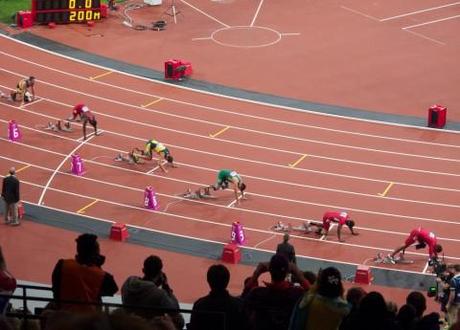 Men’s 200m at the London 2012 Paralympics
Men’s 200m at the London 2012 Paralympics
The background
The Paralympic classification system, set in place to ensure fair competition, is one of the most crucial and controversial aspects of Paralympic sport; it is also one of the most confusing. Can’t work out your S6 swimmers from your F42 athletes? Worry not.
The letter will often denote the sport; F for field, T for track and S for freestyle, backstroke and butterfly, for example. The number indicates the impairment – the lower the number, the more severe the impairment is considered. Once athletes have received their classification, they are then placed in a corresponding group for competition, meaning they are competing against athletes of a similar impairment and ability level.
The Telegraph has also compiled a handy guide to navigating your way around the classification system, explaining such complex concepts as RAZA, the point scoring system for athletics: “A mathematical formula is applied to each athlete’s throw or jump distance to calculate a points score. The athlete with the highest score wins, meaning the athlete with the least impairment does not receive an unfair advantage.”
The confusion
Whilst the classification and points system ensures fairness, it also provokes confusion, such as the fact that British long jumper Stefanie Reid was only awarded silver, despite twice breaking the Paralympic record and beating Australian Kelly Cartwright, who eventually took gold. The athletes competed against each other, but had different classifications F42 and F44. The Independent called this “one of the Paralympics’ near inevitable idiosyncrasies” and Reid told the paper: “It’s obviously quite a controversial area and it is really disappointing that they chose to combine the events on a points system.”
The controversy
The complexity of classification boundaries is not only confusing audiences but infuriating athletes. A miscalculation over the RAZA points system led to the wrong medals being awarded in the women’s discus. Just hours after Ukraine’s Mariia Pomazan proudly received her gold medal, the scorings were proved to be incorrect, and she was relegated to silver. The subsequent reshuffle meant that all of the top five positions were changed and a new medal ceremony was held on Saturday. Pomazan told The Evening Standard: ”I was very, very angry. I didn’t even know I could be that angry.”
IPC classification isn’t the only thing angering athletes: Runner Oscar Pistorius of South Africa made headlines on Monday after he lost gold to Brazilian Alan Oliviera in the men’s 200 meter race, and lashed out: “We are not running in a fair race here.” Though he has subsequently apologised for the timing of his remarks, he maintains his objection that the length of Oliviera’s blades gave him an unfair advantage.
Tactical game play?
Chief medical classifier of the IPC, Peter Van der Liet told The Telegraph that athletes are often entered into groups by their home nations that would give them a higher chance of winning medals: “Sometimes there’s an agenda going on…It’s tactical.” This issue was raised by the re-classification of US swimmers Mallory Weggemann and Justin Zook into a group more fitting for their impairment, overturning the classification awarded to them by the United States Paralympic Committee that would have, arguably, given them an unfair advantage. Similarly, US swimmer Victoria Arlen faced the challenge of gaining eligibility, after her US classification was thrown out and a ruling stated that she was too able-bodied to compete. She successfully appealed the decision and was cleared for competition hours before her final.
It’s fair – says the IPC
Van der Liet defended the IPC’s system and stresses it must be vigilantly reviewed and properly explained: “It’s the unique part of the Paralympic movement and it’s the one that requires all our attention and priority to ensure that we have the fairest possible systems, hand in hand with the right communication strategy, so that the audience understand what it’s about.”
More in Paralympics
- Top four shocks of the London 2012 Paralympics – so far
- Paralympics continue Olympic cheer
- Buzz builds for Paralympics
- Paralympics opening ceremony is a storm of ideas

